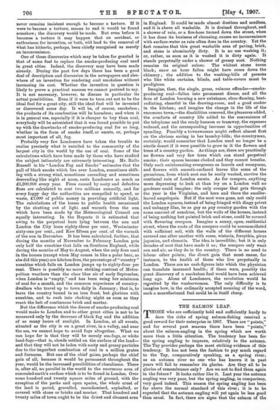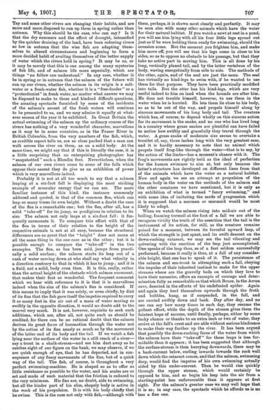THE SALMON LEAP.
THOSE who are sufficiently bold and sufficiently hardy to dare the risks of spring salmon-fishing received a good reward for their enterprise in 1907. There are " points," and for several past seasons there have been " points," about the salmon-angling in the spring which are worth more than a little attention. The tendency has been for the spring angling to improve, relatively to the autumn. The Tay provides perhaps the most striking evidence of this tendency. It has not been the fashion to pay much regard to the Tay, comparatively speaking, as a spring river; as an autumn river no one who has known it in past years will fail to remember its glories. Are they all to be glories of remembrance only? Are we not to find them again in the future ? It looks rather like it. Last year the autumn angling was very poor, but the spring angling, in comparison, very good indeed. This season the spring angling has been far above the normal standard of this river ; it is to be expected that the autumn angling will yet again be less good than usual. In fact, there are signs that the salmon of the Tay and some other rivers are changing their habits, and are more and more disposed to run up them in spring rather than autumn. Why this should be the case, who can say ? Is it that the dry summers and the effect of drought, intensified by the quicker draining of the land, have been reducing rivers so low in autumn that the wise fish are adapting them- selves to altered circumstances and beginning to form a more decided habit of availing themselves of the better supply of water which the rivers hold in spring ? It may be so, or it may be merely that this is one among the many mysteries of fish life, and of salmon life more especially, which are things "no fellow can understand." In any case, whether it be in spring or in autumn that the salmon of the future will run up our rivers, whether the salmon in its origin is a salt- water or a fresh-water fish, whether it is a " free-fooder" or a "protectionist" in fresh water, no matter what answer we may be disposed to make to these and kindred difficult questions, the amazing spectacle furnished by some of the incidents of the salmon's ascent of the fresh waters will continue to be presented to us, and we may admire it equally at what- ever season of the year it be exhibited. In Great Britain the actual swimming of the salmon up the ordinary course of the rivers has nothing of a very wonderful character, marvellous as it may be in some countries, as in the Fraser River in British Columbia, from the very numbers of the fish, which, as credible report tells us, are so close packed that a man can walk across the liver on them, as on a solid body. At the came time, we might say that if this is literally the case, it is a little surprising that no enterprising photographer has " enapshotted" such a Blondin feat. Nevertheless, when the salmon of our own rivers come to some of the falls which oppose their ascent they do give us an exhibition of power which is very marvellous indeed.
Probably it is not at all too much to say that a salmon leaping at a six-foot fall is displaying the most striking example of muscular energy that we can see. The more familiar instance of this kind, the instance commonly adduced and quoted, is that of the common flea, which can leap so many times its own height. Without a doubt the case of the flea is a remarkable one; but the flea, after all, has a solid " take-off " for its jump, so prodigious in relation to its size. The salmon not only leaps at a six-foot fall: it fre- quently surmounts it. To compare this effort with that of the flea in terms of their relation to the height of the respective animals is not at all easy, because the structural differences are so great that the "height" does not mean at all the same thing in the one case as in the other ; but it is possible enough to compare the " take-off " in the two examples. The flea, as has been said, jumps from practi- cally a solid surface ; the salmon starts its leap out of a rush of water moving down at who shall say what velocity in a direction contrary to that in which it has to jump ; and it is a fluid, not a solid, body even then. It is this, really, rather than the actual height of the obstacle which salmon surmount, that makes their feat so wonderful. The frequent comment which we hear with reference to it is that it is marvellous indeed when the size of the salmon's fins is considered. If this means to imply that it was solely, or even chiefly, by dint of its fins that the fish gave itself the impetus required to carry it so many feet in the air out of a mass of water moving so swiftly in the opposite direction, it would no doubt add to the marvel very much. It is not, however, requisite to seek such additions, which are, after all, not quite such as should be credited, for there can be no rational doubt that the salmon derives its great force of locomotion through the water not by the action of its fins nearly as much as by the movement of the latter end of its body and the tail. If we watch a fish lying near the surface of the water in a still reach of a river— say a trout in a chalk-stream—and see him dart away as he catches sight of our figure on the bank, we may observe, if we are quick enough of eye, that he has departed, not in con- sequence of any fussy movements of the fine, but of a quick wag of the tail. The fish, of course, is throughout a very perfect swimming-machine. He is shaped so as to offer as little resistance as possible to the water, and his scales are so set and made of such material that the friction is reduced to the very minimum. His fins are, no doubt, aids to swimming, but all the hinder part of his slim, shapely body is active in the work of his propulsion. It is with his body chiefly that he swims. This is the case not only with fish,—although with them, perhaps, it is shown most clearly and perfectly. It may be seen also with many other animals which have the water for their natural habitat. If you watch a newt at rest in a pond, you will see him lying with all his four little legs spread out just as if he were holding them ready for swimming, should the occasion come. But the moment you frighten him, and make him move off, you will see that his legs come in close to his sides, so as to oppose no obstacle to his passage, but that they take no active part in moving him. This is all done by his long, vertically planed tail, and by the latter vertebrae of the body, waving energetically from side to side. The methods of the otter, again, and of the Beal are just the same. The seal has virtually no hind-legs to swim with, if be wanted to use them for that purpose. They have been practically modified into tails. But the otter has his hind-legs, which are very useful indeed to him on land when the hounds are after him. He does not trouble himself, however, to use them in the water when he is hurried. He lets them lie close to his body, so as to be out of the way, and propels himself along by sinuous movements of his long body and tail. The creature which has, of course, to depend wholly on this sinuous action for its movement is the snake, and no one who has lived long in a country where grass snakes are plentiful can have failed to notice how swiftly and gracefully they travel through the water. A grass snake of moderate size seems to overtake .a troutlet of, say, three inches long with the very greatest ease, and it is hardly necessary to note that no animal which propels itself frog-like through the water—that is to say, by the action of the limbs—has a moment's chance with it. The frog's movements are rightly held as the ideal of perfection for the human swimmer to aim at, but only because the latter's structure has developed on different lines from that of the animals which have the water as a natural habitat. Now and again we see an attempt at propulsion of the human body in the water on the methods of the salmon and the other creatures we have mentioned, but it is only as .an exhibition of what is termed " fancy swimming," and with some idea of imitating the mode of progression which it is supposed that a merman or mermaid would be most likely to adopt.
When we watch the salmon rising into mid-air out of the boiling, foaming turmoil at the foot of a fall we are able to recognise vividly the truth of the assertion that the tail is the instrument of its action, for still, as the creature remains poised for a moment, between its forceful upward leap, of which the strength is just spent, and its swift descent on the down-rushing cataract, we may see the tail vibrating and quivering with the exertion of the leap just accomplished. One speaks of the leap thus, as of a feat seldom successfully performed, because it really is thus, at a fall of any consider- able height, that one has to speak of it. The persistence of the salmon and sea-trout in attempting such a fall, obeying the impulse of their inherited instinct to make for the upper streams where are the gravelly beds on which they love to have their nurseries, offers an example of courage and deter- mination fully as remarkable as that which Bruce, in the Arran cave, descried in the efforts of his undefeated spider. Again and again they hurl themselves upwards through the froth and bubbles, hang, as if suspended, in the fall, and are carried swiftly down and back. Day after day, and no one can say how many times in each day, they resume the gallant effort, while the depth of the stream gives them the faintest hope of success, until finally, perhaps, either by some lucky chance or thanks to an extra inch or two of water, they arrive at the fall's crest and are able without serious hindrance to make their way further up the river. It has been argued that possibly the down-rushing force of the water from which the salmon have their " take-off " for these leaps is less for- midable than it appears ; it has been suggested that although the surface-stream is then hurrying downwards, there may be a back-current below, curling inwards towards the rock wall down which the cataract comes, and that the salmon, swimming deep, would find the impetus of his own swimming actually aided by this under-current. Then he would rise quickly through the upper stream, which would certainly be opposed to him, and so begin his leap into the air from a starting-point less unfavourable than it appears at first sight. For the salmon's greater ease we may well hope that it is so; in any case, the spectacle which he affords us is no less a fine one.















































 Previous page
Previous page